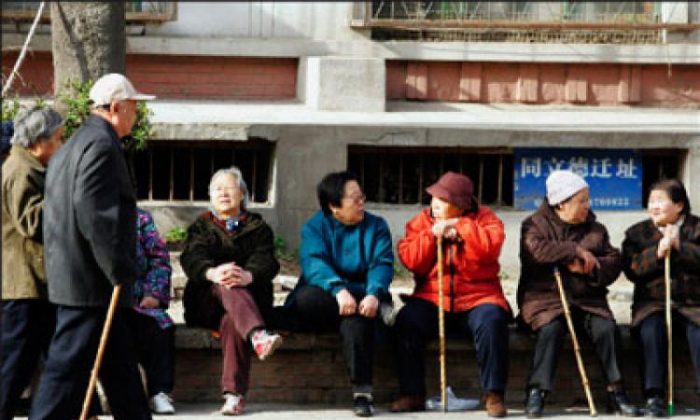News Analysis
The topic has been discussed in parks and tea parlors across China for a decade. The delay in China’s official national retirement age is now almost a certainty.
This is a first step in attempting to solve a monumental challenge—confronted by a nation facing a reeling economy and declining demographic trends.
A five-year retirement reform blueprint was released last month following the Chinese Communist Part (CCP)’s Third Plenum meeting. China plans to increase the statutory retirement age on more than 500 million workers by introducing “voluntary participation with appropriate flexibility.”
The appropriately vague language in this case is not to inject uncertainty, but to blunt its impact. China’s dual challenges of an aging population and declining birth rates—along with anemic economic growth—is taxing the country’s social security and pension system.
China’s rapidly aging population and longer life expectancy is a burden to the system. In the 9 years from 2012 to 2021, China’s elderly dependency ratio rose from 12.7 percent to 20.8 percent—meaning every 100 workers had almost 21 retirees to support in 2021, up from 13 in 2012—according to data published by Caixin, a mainland China-based business magazine. At the current pace, China’s state pension funds will run out in about a decade.
Beijing is in a race against time to reform and bolster its public pensions.
Relic of a Planned Economy
China’s present dilemma is tough to solve due to several historically and socially imbedded issues.
To begin with, its mandated retirement ages are low due to China’s legacy as an agricultural and industrial economy where most people were laborers. Blue collar female workers retire at 50, white-collar female workers retire at 55, and the retirement age for all male workers is 60. In the United States, 62 is the early retirement age and 67 is the full retirement age to receive social security benefits.
Plenum meeting minutes did not share details on proposed retirement reforms. Chinese Academy of Social Sciences, a national think tank, recently published papers suggesting that retirement age be raised to 65 for men and women as soon as within five years.
China’s pension system is analogous to a stool with three legs. The first is a basic state-run pension program which covers almost every citizen, and this is divided between one pension for urban employees and one serving rural residents. This is the one most workers rely on. The second leg is run by businesses and consist of annuity programs, similar to defined benefit plans in the United States. The third pillar is personal pension, and this is still in its infancy and is constrained by China’s stock and financial market declines.
Both employees and employers are required to make contributions to the government pension programs. The higher one’s wages, the more one pays into the system.
Slow Reforms
But China has recently run into a problem—a contradiction, to be exact.
Beijing is desperate to increase contributions into what is the world’s largest social security system to support an aging population. But simultaneously it faces growing calls to reduce the financial burden on businesses and employees facing stagnant growth and wages.
It has been tinkering with reforms. Every summer, social security contribution rates increase along with the release of prior year’s national wage data.
Back in 2013, policymakers first proposed raising the retirement age “in progressive steps,” but details were never published. In 2019, the State Council—China’s cabinet—cut pension overall contributions by employers from 20 percent to 16 percent while decreasing payouts related to workplace injuries and unemployment. 2020, the pandemic year, introduced temporary exemptions or reductions in social security contributions.
Lightening the financial tax on businesses while simultaneously reducing benefits has been part of local governments’ toolkit to support growth and appease small and medium-sized businesses facing a slowing economy.
In 2020, in the CCP’s “Five-Year Plan,” it reiterated delaying the national retirement age, though again without a concrete plan.
Later, in 2022, Beijing introduced new reforms to pool regional and provincial pension funds to transfer funds from regions with a surplus to regions with deficits.
These half-measures and slow rollout of concrete plans over more than a decade reflect the CCP’s concerns over social stability amidst declining economic growth prospects. The fundamental problems, however, remain unsolved.
Impacts on the Young and the Old
China has reached a point today where it can no longer kick the can down the proverbial road. The Plenum minutes along with officially sanctioned new reports and commentary suggest reforms are near.
The country is aging quickly, with a small number of young people supporting a disproportionately large group of elderly retirees. Even the CCP’s own statisticians and officials don’t believe the country can meet its obligations within a decade when more than 500 million people, or more than 40 percent of its population, will be over 60.
The older population faces significant challenges. In addition to the pension scare, other nest eggs are also in jeopardy. China’s real estate crash, which began in 2021 and still lingers, has depleted billions of dollars from the coffers of middle-class families.
And keeping older workers in their jobs longer requires more than just an edict. China needs to introduce policies to support older workers and loosen its historically strict workforce mobility laws.
Yet, China’s youth unemployment rate remains stubbornly high since the pandemic. Despite a small dip this year, jobless rates for 16 to 24-year-olders remain at more than 13 percent as of June.
By increasing the retirement age for older workers, China is inadvertently limiting job opportunities for younger workers. However, the job market in China is complex, with a significant number of college-educated graduates competing for a limited number of high-paying positions. This has forced many young Chinese individuals to choose between accepting lower-paying blue-collar jobs or remaining unemployed.
Adding to the challenges is China’s declining birth rate, which has been steadily decreasing since 2017. Last year, the number of newborns reached a record low of 9.0 million, contributing to India surpassing China as the world’s most populous country.
The decision to delay the retirement age further exacerbates the issue of low birth rates, as young people can no longer rely on their parents for childcare support. This creates additional strain on an already struggling workforce.
It is crucial for policymakers to consider the long-term impact of these decisions on both the job market and the population as a whole. The views expressed in this article are the author’s own and may not necessarily reflect those of The Epoch Times.
Source link





